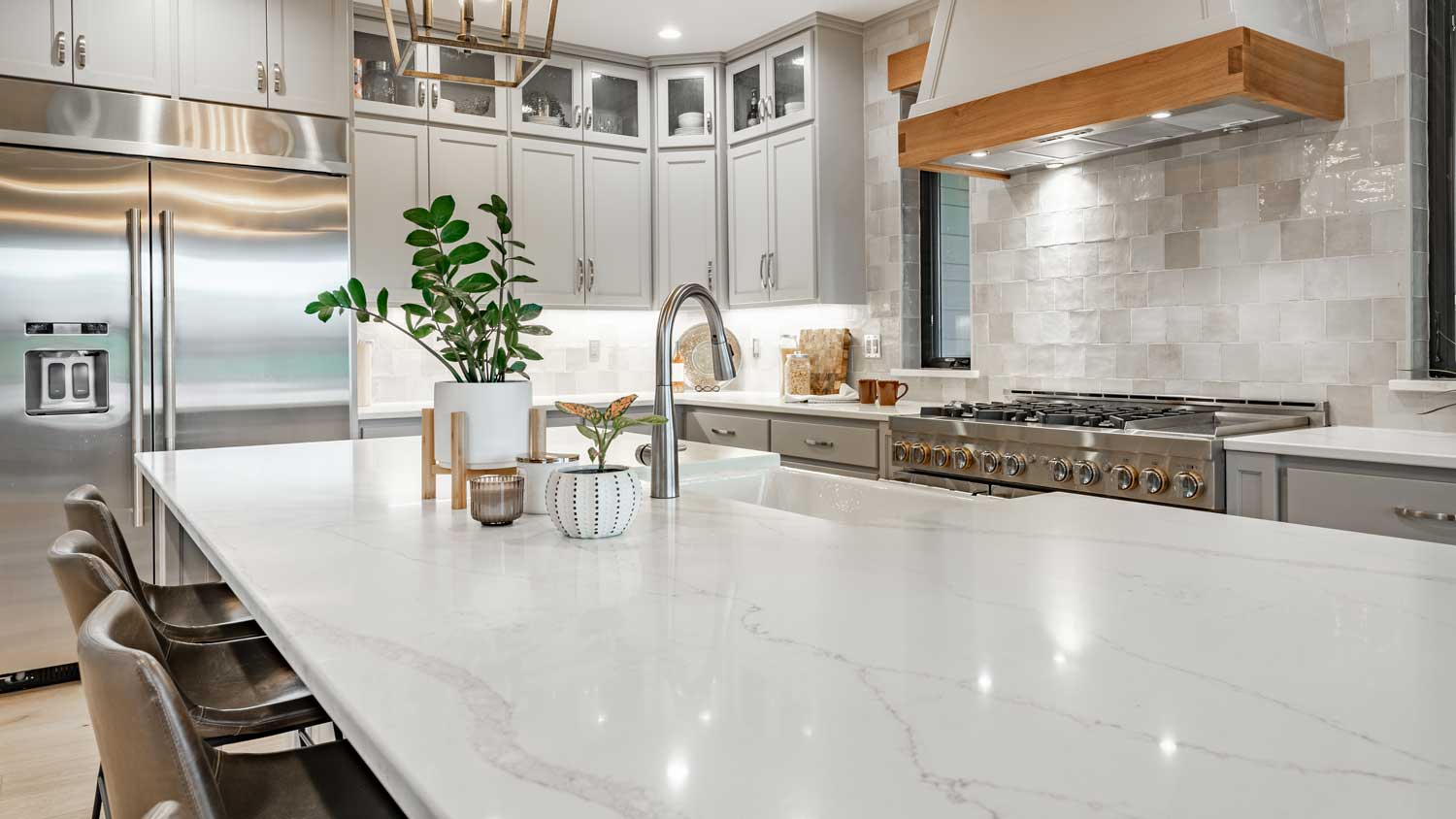How to Seal Marble Countertops: Protect These Porous Surfaces in 7 Steps
Sealing marble helps it stay clean and beautiful


- Drop cloths
- Paintbrush
- Foam applicator pad
- Acetone (optional)
- Disposable gloves
- Marble sealer
- Mineral oil (optional)
- Painter’s tape
If luxurious marble countertops are the star of your stylish kitchen, you want to keep them looking their best. Learning how to seal marble countertops means you don’t have to panic when someone splashes coffee or lemon juice on these porous surfaces. Regular marble maintenance doesn’t make the surface stain-proof, but you won’t have to mop things up so quickly.
Test If Your Marble Countertop Needs Sealing
It’s worth checking each month to see how the seal on your marble countertops is holding up. You’ll know it’s ready for resealing if liquids absorb into it too quickly. You can test the sealant in two ways.
Put a few drops of mineral oil on an out-of-sight section of the counter. If a dark stain shows up when you wipe the oil away with a dry cloth after 10 minutes, it’s time to spread the sealant. And don’t panic about the stain—mineral oil evaporates well from stone surfaces, so it should disappear within an hour.
Alternatively, sprinkle drops of water onto the marble. If it absorbs into the stone rather than beading on the surface within 15 minutes, crack open the sealant.
Clean Countertop Surfaces
 Photo: LPETTET/ istock/ Getty Images
Photo: LPETTET/ istock/ Getty ImagesThoroughly clean marble before sealing so you don’t trap mold and bacteria-creating debris on the surface.
Remove crumbs with a clean, white microfiber cloth, and then clean the marble surface with a neutral marble cleaner or a mild, pH-balanced dish soap and warm water solution. Avoid harsh acidic cleaners, which can dull your marble's natural shine. Use a dry cloth to wick away any excess moisture. For hard-to-remove residues, you can blot with fast-evaporating acetone.
Allow the marble to air dry overnight—you don’t want to seal in any lingering moisture.
Protect Floors and Wall Edges
To avoid getting sealant on your backsplash, painted walls, or floors, apply painter’s tape along the edges of your countertop and lay down drop cloths.
Test the Sealant
As a precaution, test the sealer you select on an inconspicuous corner of your marble countertop before covering the whole surface. Before you get started, ventilate the space well to improve your indoor air quality—sealers often contain volatile organic compounds (VOCs) that emit harmful gases. Open windows and, if you have one, turn on a fan.
Put on disposable gloves when applying the sealer and wait to see if it causes discoloration. Normally, you should only have to wait around 15 minutes, but always check the manufacturer’s instructions.
If the sealant results in discoloration, contact a marble countertop specialist near you for advice on the best product.
Apply the Sealant
Pour some sealant into a portable, wide-mouthed container to minimize messy drips, and use a foam paintbrush or applicator pad to apply the sealant. Load the applicator generously (but not so much that it drips) and use overlapping, even strokes. Work methodically in sections to ensure all areas of the countertops receive an even covering.
After 15 minutes, remove any excess sealant on the surface with a dry, clean microfiber cloth.
Apply an Extra Coat (If Necessary)
If your marble countertops suck up all the sealant within 5 or 10 minutes, apply another coat to provide sufficient protection. The wait time between coats depends on the product, but you usually only have to hold off for 15 to 30 minutes before rolling up your sleeves again.
Buff the Countertops
 Photo: DragonImages/ istock/ Getty Images
Photo: DragonImages/ istock/ Getty ImagesMaximize your marble countertop’s luxurious luster by buffing the surfaces after sealing. Work across the countertops with a clean, dry, soft microfiber cloth. Use circular motions and replace the cloth with a fresh one once all the sections are damp.
Allow the sealant to cure for another 24 hours before placing countertop appliances and accessories.
DIY vs. Hiring a Pro
Most homeowners can seal marble countertops. It’s quick, easy, and doesn’t require specialist tools or safety precautions. It’s also inexpensive—even a high-quality sealant for large countertops might cost less than $50.
If you don’t have the time or inclination to tackle this regular marble maintenance task, you can hire a local marble and granite pro. The cost for professional marble countertop sealing might set you back $100 to $350 each time, and it’s something that you need to do at least once a year—and possibly more regularly for high-traffic surfaces.
Frequently Asked Questions
Marble is a porous natural stone that needs sealant to minimize staining. Leaving this type of countertop material sealant-free means any liquids left on the surface will quickly absorb into the stone, discoloring it and dulling the sheen. Dark or acidic liquids, like red wine, coffee, and lemon, are the worst culprits.
A water-based, low- or no-VOC sealer is typically a good choice for marble countertops. Choose a sealant that is certified safe for contact with food when applying to kitchen countertops. For high-traffic areas, look for formulas that have heat-resistant and acid-resistant features. While there are economical and convenient spray-on sealers, they don’t coat the surface as effectively as the ones you apply with a pad or brush.
How often you need to reseal marble countertops depends on the quality and color of the stone, the traffic on the surface, and the type of sealant. Sealing at least once a year is the general rule of thumb. However, if your large family loves to cook or the countertops are in a busy family bathroom, you might have to reseal them every six months (or more). The surfaces of your rarely used guest bathroom might not need resealing for a few years.















